Next generation wireless communication systems are expected to relay on integrated networks consisting of multiple wireless technologies. Heterogeneous wireless networks, for instance WiMAX and Wi-Fi can combine their respective advantages, offering a high Quality of Service (QoS) and Always Best Connected with mobile users. Mobility management was deployed in Application layer using SIP protocol to provide quality of Real time services to the end user. The vertical handoff decision is crucial in heterogeneous networks. In this paper, we propose Enhanced vertical handoff decision based on BANS in WiMAX and Wi-Fi heterogeneous wireless networks. The algorithm consider the factors of Received Signal Strength (RSS), Bandwidth (BW), mobile node velocity (V) and User Preference (P), to evaluate Network Selection Function of the available networks and select best one which support on going real time application (i.e., video streaming).To decrease Call Blocking Probability we propose Adaptive Bandwidth Allocation Algorithm(ABAA). We propose TBHO method to make an early handover to avoid Ping-Pong effect which causes the unwanted packet loss.
Keywords |
| |
| Heterogeneous wireless networks, Network
Selection Function, Adaptive Bandwidth Allocation
Algorithm, Received Signal Strength, and Time before
Handoff |
| |
INTRODUCTION |
| |
| Communication technology has become outdated for
future requirement as the growth of the communication
industry is tremendous and unimaginable. Different modes
as mobile, wired, wireless, adhoc, supports growth of the communication industry but with certain limits. Mobility
plays a vital role in wireless communication, where it is
necessary to satisfy the requirements of the modern world.
It is now a challenge to provide the seamless flow of
information without re-modifying the existing
infrastructure. The most challenging aspect is to provide
mobility management for real time communication
services. |
| |
| Mobile IP is struggling with the triangular routing, i.e., a
packet to a mobile host travels via the home agent from the
correspondent node which incurs overhead of tunnelling
[1]. To solve triangular routing through route optimization
by sending binding updates to the sending host about the
actual location of the mobile host. For real-time traffic such
as voice or video over IP, it is more common to use the
Real-Time Transport Protocol (RTP) over UDP, and
important issues are fast handoff, low latency, and for
wireless networks, high bandwidth utilization. Hence, this
necessitates introducing mobility awareness at higher layer.
The application layer protocol Session Initiation Protocol
(SIP) [2] already supports personal mobility, and the
changes needed to support device mobility are minor. |
| |
| In heterogeneous wireless networks, traditionally the
network is initiated with any request and immediately the
type of request is identified as voice, data, image, data and
image, motion pictures, live information, online videos,
store and forward. In case of emergency situation such as
natural calamities and disaster requires immediate recovery
and medical help. The medical experts can establish virtual
communication such that the experts from remote areas can
view the condition of the patient and provide directions for
initial treatment until they reach the affected area. This can be achieved only if seamless mobility is possible in reality.
Seamless and efficient Vertical Handoff between different
access technologies is an essential and challenging problem
in the development toward the next-generation wireless
networks [3]. The handoff process can be further carried
out using the following steps: neighbour discovery, handoff
decision and handoff execution. During the neighbour
discovery phase, mobile terminals equipped with multiple
interfaces have to determine which networks can be used
and the services available in each network. During the
handoff decision phase, the mobile device determines
which network it should connect to. During the handoff
execution phase, connections need to be rerouted from the
existing network to the new network in a seamless manner. |
| |
| One of the main purposes of so-called fourth
generation (4G) [4] networks is to allow mobile users to be
always best connected (ABC) through a number of
underlying wireless technologies and networks. It is
expected that wireless devices will increasingly have
multiple heterogeneous interfaces. In this scenario the
selection of the most appropriate network should be based
on various criteria such as economic cost, coverage, and
transmission rate, quality of service (QoS), security, and
user preferences [5] . Efficient schemes are needed to
provide seamless vertical handovers in integrated
heterogeneous networks. New heterogeneous networks,
including IEEE 802.11 wireless LANs, and IEEE 802.16
wireless metropolitan area networks [6], also known as
worldwide interoperability for microwave access
(WiMAX), seem to be promising approaches as both
technologies support very high data rates as well as QoS.
Hence, this integrated network will bring a synergetic
improvement to the services provided to mobile users. The
integration and inter operation of these heterogeneous
networks pose several challenges. One of the important
issues is the design of intelligent network selection
algorithms is to provide better performance to the multiinterface
terminals. This paper proposes a network
selection algorithm based on multiple attribute decision
making. A handoff algorithm must be capable of making a
decision based on incomplete information and in a region
of uncertainty. |
| |
| A. Organization of the paper |
| |
| Section II presents the proposed method. Section III
presents the results and related discussion. Section IV discusses directions for future work and concludes this
study. |
| |
SYSTEM MODEL |
| |
| The proposed system for best access network selection
is shown in fig.1. The Mobile Node is a multi-interface and
multitask device (eg: small-size multi-band antenna). The
Home Agent (HA) is a specialized router responsible for
forwarding packets to Mobile Node. The Mobile Node is
assigned a home address (HoA) in the same subnet as the
Home Agent [8]. The Foreign Agent is responsible for
assigning a care of address (CoA) for the Mobile Node and
forwarding packets for the Mobile Node. On its home link,
the mobile node uses its HoA just like a stationary node. |
| |
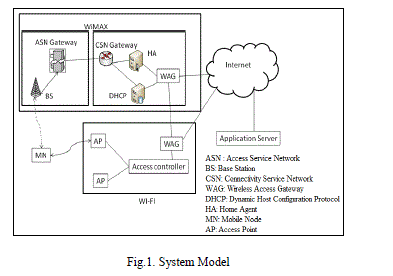 |
| |
| Mobility Management incorporates Session Initiation
Protocol and location management is handled through SIP
Registrar servers. The SIP session is been established from
the mobile node through the home agent which acts as the
SIP server to the CN. Once the session is established then
RTP packet streaming takes place. When the MN Received
Signal strength reduces below the threshold, the access
network selection is triggered, taken care by the controller.
The access network selection algorithm determines the next
network for the mobile node to avoid re-connection latency
with CN. The mobility of the MN remains transparent to
the correspondent node [9]. |
| |
| A. Signaling through SIP |
| |
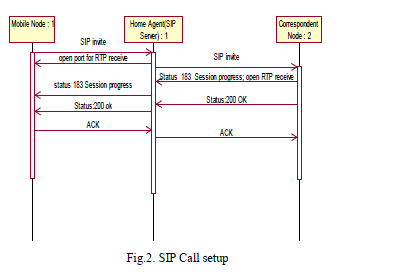 |
| |
| SIP supports personal mobility, i.e., a user can be
found independent of location and network device (PC,
laptop, IP phone, etc.). The step from personal mobility to
IP mobility support is basically the roaming frequency, and
that a user can change location (IP address) during traffic
flow. In order to support IP mobility, we enable the ability
to move while session is active. It is assumed that the MN
belongs to a home network, which acts as SIP server and
receives registrations from the MN each time it changes
location. This is similar to home agent registration in
Mobile IP. Note that the mobile host does not need to have
a statically allocated IP address on the home network.
When the correspondent host sends an INVITE to the
mobile host, the home agent has current information about
the mobile host’s location and redirects the INVITE there
(Fig.2). SIP specifies support for both authentication and
encryption of SIP messages, using either challengeresponse. |
| |
| B. Streaming using Real time Transport Protocol
(RTP) |
| |
| Once the session is initiated between the MN and the
CN, packets are streamed to the MN from the CN. The MN
regularly sends BU messages to the HA indicating its CoA
[10]. When a new CoA is indicated in the BU message, the
HA updates the binding cache and returns Back messages
to the MN. Packets in the direction from the MN to the CN can be sent directly to the CN when BU is sent to the CN.
Thus triangular routing problem is overcome through route
optimization. |
| |
| C. Best Access Network Selection |
| |
| Once the received signal strength of the MN reduces
below the threshold, the MN notifies CN with ―Handover
notification Message‖ and Best access Network Selection
Algorithm is initiated, which selects the next optimal and
promising to maintain the QoS for the application. The
network selection algorithm is based on Fuzzy multiple
attribute decision making [13]. The algorithm considers the
factors of Received Signal Strength (RSS), available band
width (BW), mobile terminal velocity (V) of the candidate
networks for choosing the target network. |
| |
| i. Finding Normalizat ion Functions: |
| |
| Different kinds of parameters can be considered for
finding the best access network. Each parameter has some
characteristic which contributes for normalizing function
and hence determine the best access network [11]. The
parameters that are considered for making handover
decision are defined in table 1. The parameters are
classified as high parameters and low parameters to
facilitate normalization. |
| |
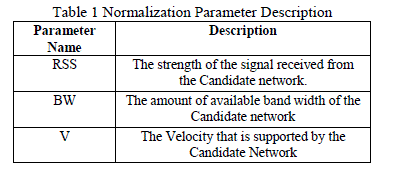 |
| |
| The Normal ization Funct ion is given as follows : |
| |
 |
| |
| Normalization functions for RSS: |
| |
 |
| |
| RSSx - received signal strength from the candidate base
station. RSSTH – threshold signal strength. RSSmax is the
maximum received signal strength received from the base
station. RSS – signal strength received from the base
station. |
| |
| Normalization function for Bandwidth |
| |
 |
| |
| BWX – required bandwidth of mobile node and BWmax -
Maximum bandwidth that can be provided by the base
station. |
| |
| Normalizat ion funct ion for Velocity [15] |
| |
 |
| |
| Where VX – velocity with which the mobile node is
moving and Vmax – maximum velocity supported by the
base station. |
| |
| ii. Computation of the Weight Vector: |
| |
| The weight of an attribute is denoted by ―i‖. Wi
indicates the importance of the attribute. The weight is
represented as WRSS, WBW, WV. Wi is given by |
| |
 |
| |
| Where σi is the standard deviation of the normalization
function values of all the candidate base stations for the
given parameter ―i‖. |
| |
| iii. Evaluation of Network Select ion Funct ion: |
| |
| The network selection function (NSF) for the
candidate network is calculated by |
| |
 |
| |
| After evaluating the NSF values for all the candidate
networks decision is made as follows. The kth network is
selected with the Network having highest NSF value, |
| |
 |
| D. Call Admission Control |
| |
| Call Admission Control [12] is always performed
when a mobile initiates communication in a new cell, either
through a new call or a handoff. The flowchart for Call
Admission is shown in Fig. 3. |
| |
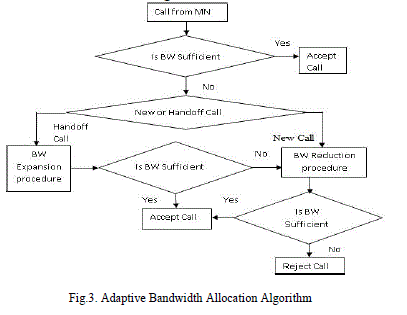 |
| |
| During call setup, MN running a user multimedia
service defines its requirements in a traffic profile. This
profile consists of the connection type (new or handoff)
and the BW requirements. |
| |
Adaptive Bandwidth Allocation Algorithm |
| |
| The adaptive bandwidth allocation (ABA) algorithm is
utilized to adapt calls whenever there is an insufficient
bandwidth for call admission [13]. The algorithm will be
triggered whenever there is a call arrival acceptance event
or a service departure event. A class-i handoff connection
is accepted if the following is satisfied. |
| |
 |
| |
| t0 Denotes the maximum number of total bandwidth units
that can be allocated to new / handoff connection. |
| |
| bA
Denotes the bandwidth in the cell. |
| |
| bnic
Denote the total capacity allocated for class-i new
connections |
| |
| bni
Denote the total capacity allocated for class-i handoff
connections. |
| |
| E. Binding Messages |
| |
| The MN initiates access request to the
selected network (Fig.4.), which then provides ACK for the
requested access. Once ACK is received the MN sends BU
to the access router of the selected network [14]. Once it
receives the binding acknowledgement message from the
access router, the MN performs BU to the HA and then
with the CN. Hence packet transfer takes place directly
between the MN and the CN. |
| |
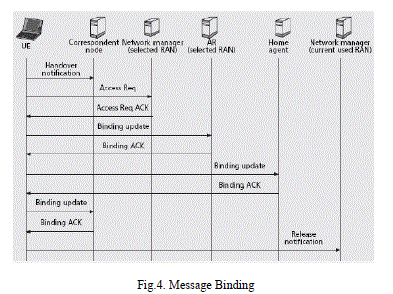 |
| |
| F. Handover Prediction and Execution |
| |
| Two BS are considered in our proposed
approach, one is old BS (OBS) where the call generates
and other is new BS (NBS), next destination of the MN.
When the MN tends to move out the coverage area of OBS
it needs handoff with NBS to continue the call. |
| |
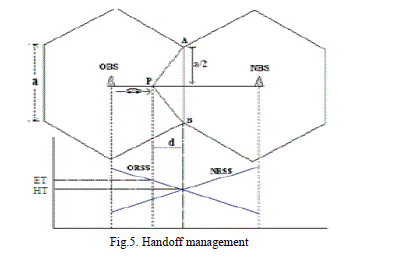 |
| |
| EaT (Exit Threshold) = the threshold value of the RSS to
initiate the handoff process. When the RSS of OBS drops
below, the MN starts the registration procedures for
handoff to new BS (NBS). |
| |
| HT (Handoff threshold) = the minimum value of RSS
required for successful communication between the MN
and OBS. |
| |
| a = cell size. |
| |
| d= threshold distance from cell (OBS) boundary |
| |
| From the Fig.5., the time before vertical
handover is determined as follows. The time during which,
the connection would be terminated and would cause
packet loss. To avoid this, time before handover is
calculated. |
| |
 |
| |
| When the handoff delay is less than TBHO, the buffer is
triggered the gateway between the different network. |
| |
RESULT AND PERFORMANCE ANALYSIS |
| |
| The results to provide the seamless flow of
information in a practical context that addresses the
integrating of WiMAX and Wi-Fi access networks are
considered. In order to implement the different functions
listed earlier, some initial technological choices need to be
made. Intra technology handoffs are taken care of by
technology-specific mechanisms. Then Mobile IP has been
chosen as the L3 protocol for handoff execution in the
proof of concept and is used on top of either IPv4 or IPv6
in order to provide session continuity during inter
technology handoff. A clear separation of handoff decision
and execution processes allows any evolution of IP
protocols to minimize new care-of address configuration
and rerouting latencies, for instance, to replace baseline
Mobile IP without modifying the proposed architecture. |
| |
| Our simulation scenario first assumes that the coverage
area of Wi-Fi is overlapped by WiMAX and is
implemented in OmNet++. The multi-mode mobile, starts
moving towards WiMAX and then towards Wi-Fi and
stops there. We assume that the input parameters required
for best access network selection algorithm are acquired
from the network and mobile terminal. |
| |
 |
| |
| When the mobile node moves from WiMAX to Wi-Fi,
the network selection module in the mobile terminal
acquires the input parameters and normalized values of
these parameters are determined. Then network selection
function value is computed for the available networks. Due
to complexity reasons, we have directly considered the
normalized values of the parameters. The NSF computation
for all the networks is as shown in Table 2. |
| |
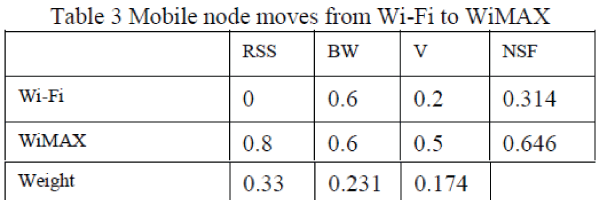 |
| |
| When the mobile node moves from Wi-Fi to WiMAX,
the network selection module in the mobile terminal
acquires the input parameters and normalized values of
these parameters are determined. Then network selection
function value is computed for the available networks. Due
to complexity reasons, we have directly considered the
normalized values of the parameters. The NSF computation
for all the networks is as shown in Table 3. The graph
plotted between Movement of the mobile node and NSF
value of each network is shown in fig. 6. |
| |
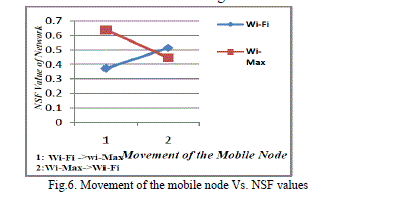 |
| |
CONCLUSION AND FUTURE WORK |
| |
| In this paper we presented a Best network selection
algorithm based on Fuzzy Multiple Criteria Decision
making that calculates the quantitative value of each
normalized parameter and finds the weight of each
quantitative value. This weight vector together with
normalized parameter values are used to evaluate Network
Selection Function of the available networks. The network
with highest NSF is selected as the target network. Since
the algorithm is taking mobility parameters like speed of
the mobile into account, it supports seamless mobility and
reduces unnecessary handoffs. Further the performance of
the algorithm can be improved by taking considering a
threshold on the NSF value in order to prevent frequent
handoffs. |
| |
References |
- C. Perkins and D. Johnson, ―Route optimization in mobile IPInternet Draft, Internet Engineering Task Force, Feb. 1999.
- ElinWedlund, Henning Schulzrinne, ―Mobility Support using SIP
- AdilineMacriga, T., P. AnandhaKumar, ―Mobility Management for Seamless Flow of Information in Wireless Networks, EuropeanJournal of Scientific Research, pp.147-155, 2011
- Chen Yiping and Yang Yuhang , “ A new 4g architecture providingmultimode terminals always best connected services, IEEEWireless Communications , April 2007
- Dong Ma and Maode Ma, ―A QoS Oriented Vertical Handoff Scheme for WiMAX/WLAN Overlay Networks, IEEETransactions, April 2012.
- IEEE 802.11 WG, IEEE Standard for Local and Metropolitan Areanetworks; Part 11: Wireless LAN Medium Access Control andPhysical Layer Specifications, IEEE Std. 802.11-2007, Feb. 2007
- IEEE 802.16 WG, IEEE Standard for Local and Metropolitan AreaNetworks; Part 16: Air Interface for Fixed Broadband WirelessAccess Systems, IEEE Std. 802.16e, Dec. 2005
- ArchanMisra, Abhishek Roy and Sajal K. Das, ―Information-TheoryBased Optimal Location Management Schemes for IntegratedMulti-System Wireless Networks, IEEE/ACM Transactions onNetworking, Vol. 16, No. 3, pp. 1426-1440, 2008.
- Daniel Morris and A. Hamid Aghvami, ―Location ManagementStrategies for Cellular Overlay Networks—A Signaling CostAnalysis, IEEE Transactions on Broadcasting, Vol. 53, No. 2,Pp. 126 -139, 2007.
- Di-Wei Huang, Phone Lin and Chai-HienGan, ―Design andPerformance Study for a Mobility Management Mechanism (WMM) Using Location Cache for Wireless Mesh Networks,IEEE Transactions on Mobile Computing, Vol. 7, Pp. 546-556,2008.
- DusitNiyato, and EkramHossain, ―A Non-cooperative Game-Theoretic Framework for Radio Resource Management in 4GHeterogeneous Wireless Access Networks, IEEE Transactionson Mobile Computing, Vol. 7, No. 3, pp. 332-345, 2008.
- Fei Yu, and Vikram Krishnamurthy, ―Optimal Joint SessionAdmission Control in integrated WLAN and CDMA CellularNetworks with Vertical Handoff, IEEE Transaction on MobileComputing, Vol 6, No. 1, pp. 126 -139, 2007.
- Haining Chen, Hongyi Wu, Sundara Kumar and Nian-FengTzeng,―Minimum-Cost Data Delivery in Heterogeneous Wireless Networks, IEEE Transactions on Vehicular Technology, Vol.56, No. 6, pp. 36–47, 2007.
- JaroslavHolis and PavelPechac, Elevation Dependent ShadowingModel for Mobile Communications via High Altitude Platformsin Built-Up Areas, IEEE Transactions on Antennas andPropagation, Vol. 56, No. 4, pp. 1078-1084, 2008.
- Mohammed M. Olama, Seddik M. Djouadi, IoannisG.Papageorgiou, and CharalambosD.Charalambous, ―Position andVelocity Tracking in Mobile Networks Using Particle and KalmanFiltering With Comparison, IEEE Transactions On Vehicu
|